SUN (Baal) WORSHIP is the ORIGIN OF
PAPAL OFFICE
NIMROD, THE
KING and founder of Babylon, was not
only its political leader,
he was
its religious leader
also. He was a
priest-king.
From him descended a line of priest kings each standing as the
head of the occult Babylonian mystery religion. This line
continued on down to the days of Belshazzar of whom we read in
the Bible.

Many are familiar with the feast Belshazzar in
Babylon when the mysterious handwriting appeared on the
wall. Some have failed to recognize, however, that this
gathering was more than a mere social party! It was a
religious gathering, a celebration of the Babylonian mysteries of
which Belshazzar was the head at that time. They drank wine,
and praised the gods of gold, and of silver, and of brass, of
iron, of wood, and of stone' (Dan. 5:41). Adding to the
blasphemy of the occasion, they drank their wine from the holy
vessels of the Lord which had been taken from the Jerusalem
temple.
This attempt to mix that which was holy with that
which was heathenism, brought about Divine judgment. Babylon was
marked for doom.
The prophets
had told how the city would be destroyed (Jer. 50:39; 51 :62).
Today there is a railroad which runs from Baghdad to Basra which
passes close by the old site. A sign written in English and
Arabic says: "Babylon Halt. Trains stop here to pick
up passengers." The passengers are tourists who come to inspect
the ruins. But though the city was destroyed, concepts that
were a part of the old Babylon religion survived!
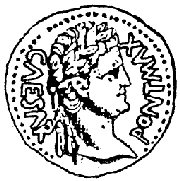
When
Rome conquered the world, the
sun
worship that had spread from Babylon and developed in
various nations, was merged into the religious system of
sun worshiping Rome.
This included the idea of a Supreme Pontiff(
Pontifex Maximus), an office
that began to be held by the Caesars in 63 B.C, This is
illustrated here by an old Roman coin of Augustus Caesar (B.C.
27-14 A.D.) with his title as the "Pont-Max," the head of the
mysteries. Coins such as this were in circulation during the
days of our Lord's earthly ministry. "And they brought unto
him a penny. And he saith unto them, Whose is this image and
superscription? They say unto him, Caesar's- (Matt.
22:17-22).
The Roman
emperors (including Constantine) continued to hold the office of Pontifex Maximus until 376
when Gratian, for Christian reasons, refused it. He recognized
this title and office as idolatrous and blasphemous. By this
time, however, the bishop of Rome had risen to political power and
prestige. Consequently, in 378 ,Demasus, bishop of Rome, was
elected the Pontifex Maximus-the
high priest of the mysteries! Since Rome was considered the most
important city in the world, some of the Christians looked to the
bishop of Rome as "Bishop of bishops" and head of the
church. And this same man was claiming the title Pontifex Maximus a unique
arrangement! By this time, and through the years that
followed, the streams of sun
worship and Christianity
flowed together, producing what is known as the Roman Catholic church, under
the headship of the Pontifex
Maximus the Pope.
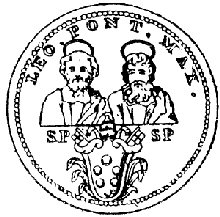
The title Pontifex Maximus is repeatedly
found on inscriptions throughout the Vatican--above the entry of
St. Peter's, above the statue of Peter, in the dome, over the Holy
Year Door which is opened only during a jubilee year, etc.
The accompanying medal, struck by Pope Leo X just before the
Reformation, illustrates one of the ways that the title "Pont. Max," has been
used by the popes.
But how could
a man be at one and the same
time both the head of the church and
the Pontifex Maximus,
the head of the sun worship mysteries? In
an attempt to cover this discrepancy, church leaders sought for
similarities between the two religions. They knew if they could
find even a few points that each side had in common, both
could be merged into one, for by this time most were not
concerned about details. They desired numbers and political power. Truth was secondary.
One striking
similarity was that the Supreme Pontiff of sun worshipers bore the
Chaldean title peter or
interpreter--the interpreter of the mysteries. Here
was an opportunity to "Christlanize" the sun worship office of Pontifex Maximus, the office
the bishop of Rome now held, by associating the "Peter" or Grand
Interpreter of Rome with Peter the apostle. But this was not
without its problems. To do so, it was necessary to teach that
Peter had been in Rome. Thus tales about Peter being the first
bishop of Rome, unknown and unheard-of in earlier times, began to
be voiced. "And so," writes Hislop, "to the blinded Christians of
the apostasy, the Pope was the representative of Peter the
apostle, while to the initiated sun
worshipers, he was only the representative of Peter, the
interpreter of their well-known mysteries."
Since the
apostle Peter was known as Simon Peter, it is interesting to note
that Rome not only had a "Peter," an interpreter of the mysteries,
but also a religious leader named Simon who went there in the
first century! This Simon, known to Bible students as Simon the
sorcerer (Acts 8:9), is said to have later gone to Rome and
founded a counterfeit Christian religion there! Because this
sounds so bizarre, in order to make it clear there is no bias on
our part, we quote the following right from The Catholic
Encyclopedia about this Simon:
"Justin Martyr
and other early writers inform us that he afterwards went to Rome,
worked miracles there by the power of demons, and received Divine
honors both in Rome and in his own country. Though much
extravagant legend afterwards gathered around the name of this
Simon, it seems nevertheless probable that there must be some
foundation in fact for the account given by Justin and accepted by
Eusebius. The historical Simon Magus no doubt founded some sort of
religion as a counterfeit of Christianity in which he claimed to
play a part analogous to that of Christ."
We know that
the Roman Catholic church became expert in taking various ideas or
traditions and mixing them together into its system of
religion. If Simon did build up a following in Rome, if he
received Divine honors, if he founded a counterfeit Christian
religion in which he played a part analogous to Christ, is it not
possible that such ideas could have influenced later
traditions? Perhaps this "Simon" being in Rome was later
confused with Simon Peter. The popes have claimed to be
'Christ in office' on earth. Apparently Simon the sorcerer
made the same claim in Rome. But we never read of any such claim being made by Simon
Peter the apostle!
Another mixture
at Rome involved "keys." For almost a thousand years, the
people of Rome had believed in the mystic keys of the sun worship god Janus and the
goddess Cybele. In Mithraism, one of the main branches of
the mysteries that came to Rome, the
sun god carried two keys, When the emperor claimed to be
successor of the "gods" and Supreme Pontiff of the mysteries, the
keys came to be symbols of his authority. Later when the
bishop of Rome became the Pontifex
Maximus in about 378, he automatically became the
possessor of the mystic keys. This gained recognition for
him from the sun worshipers
and, again, there was the opportunity to mix Peter into the
story. Had not Christ said to Peter, "I will give unto thee
the keys of the kingdom of heaven" (Matt. 16:19)?
It was not
until 431, however, that the pope publicly made the claim that the
keys he possessed were the keys of authority given to the apostle
Peter. This was over fifty years after the pope had become
the Pontifex Maximus, the
possessor of the keys. Keys are shown as symbols of the
papal authority.
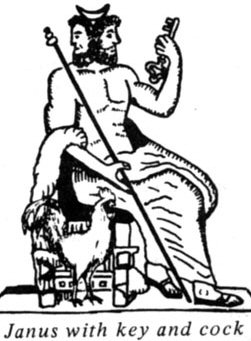
The key given
to Peter (and to all the disciples) represented the gospel message
whereby people could enter the kingdom of God. Because some
have not rightly understood this, it is not uncommon for Peter to
be pictured as the gatekeeper of heaven, deciding who he will let
in and who he won't!
This is very
much like the ideas that were associated with the sun worship god Janus, for he
was the keeper of the doors and gates in Roman mythology.
Janus, with key in hand, is shown in the accompanying
drawing. He was represented with two faces-one young, the
other old (a later version of Nimrod incarnated in Tammuz).
It is interesting to notice that not only was the key a symbol of
Janus, the cock was also regarded as being sacred to him.
There was no problem to link the cock with Peter, for had not a
cock crowed on the night that he denied the Lord? (John 18:27).
It is certain
that the title "supreme Pontiff" or "Pontifex Maximus" which the pope bears is not a
Christian designation, for it was the title used by Roman emperors
before the Christian Era. The word "pontiff comes from the
word pons, "bridge," and facio. "make." It means
"bridge-maker," The priest-king emperors of sun worship days were regarded
as the makers and guardians of the bridges of Rome. Each of
them served as high priest and claimed to be the bridge or
connecting link between this life and the next.
That branch of
the mysteries known as Mithraism grew in Rome until it became-at
one time-almost the only faith of the empire. The head
priest was called the Pater Patrum, that is, the Father of
Fathers. Borrowing directly from this title, at the head of
the Roman Catholic church, is the Papa or Pope-the Father of
Fathers. The "Father" of Mithraism had his seat at Rome then, and
the "Father" of Catholicism has his there now.
The expensive
and highly decorated garments that the popes wear were patterned
after those of the Roman emperors. The historians have not
let this fact go unnoticed, for indeed their testimony is that
"the vestments of the clergy...were legacies from
sun worshiping Rome."
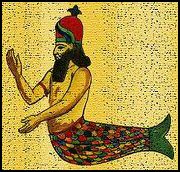
The tiara crown
that the popes wear-though decorated in different ways at
different times-is identical in shape to that worn by the "gods"
or angels that are shown on ancient sun worship Assyrian tablets. It is similar
to that seen on Dagon, the fish--god pictured here, Dagon was
actually but a mystery form of the false Babylonian
"savior." The name Dagon comes from dag(a word commonly
translated "fish" in the Bible) and means fish-god. Though
it originated in the sun worship
of Babylon, Dagon worship became especially popular among the
Philistines (Judges 16:21-30; 1 Sam. 5:5,6).
The way Dagon
was depicted on Mesopotamian sculpture is seen in the drawing
reproduced below (second figure from left). In his book
Babylon and Nineveh, Layard explains that "the head of the fish
formed a mitre above that of the man, while its scaly, fan-like
tail fell as a cloak behind, leaving the human limbs and feet
exposed."
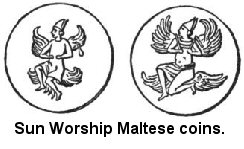
Later, in the
development of things, just the top portion remained as a mitre,
with the jaws of the fish slightly opened. On
several Maltese coins, a god
(whose characteristics are the same as those of Osiris, the
Egyptian Nimrod), is shown with the fish body removed, and only
the fish-head mitre remaining.
A famous painting by Moretto shows
St.
Ambrose wearing a mitre shaped like the head of a fish. This
same type of mitre is worn by the popes. Photo below right
shows Pope Benedict XVI in America in 2008 wearing the
fish-head mitre.
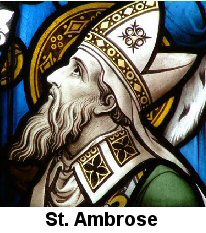
H.A. Ironside says that the pope is "the direct
successor of the high priest of the Babylonian mysteries and the
servant of the fish god Dagon, for whom he wears, like his
idolatrous predecessors, the fisherman's ring." 'Again, in
mixing
sun worship and
Christianity together, similarities made the mixture less
obvious. In this case, since Peter had been a fisherman, the
fish-god ring with the title
Pontifex
Maximus inscribed on it was associated with him.
But a ring like this was never worn by Peter
the apostle.
No
one ever bowed and kissed his ring. He probably
didn't even have one, for, as he said to the lame man, "
Silver and gold have I none"!
(Acts 3:6).

Another clue
to help us solve the mystery of Babylon modern may be seen in
the use of the pallium which the pope wears over his
shoulders. The unabridged dictionaries define it as a
garment that was worn by the sun
worship clergy
of Greece and Rome, before
the Christian Era.
In modern
times, the pallium is made of white wool which is taken from two
lambs which have been "blessed" in the basilica of St. Agnes,
Rome. As a symbol that the archbishops also share in the
plenitude of the papal office, the pope sends the pallium to
them. Before it is sent, however, it is laid all night on
the supposed tomb of St. Peter-such being a copy of
sun worship that was
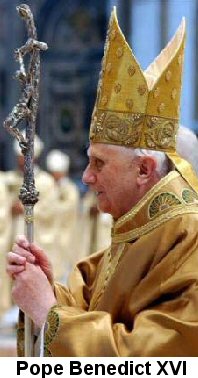
practiced
among the Greeks!
Over the
centuries the Roman Catholic church has claimed to possess the
chair in which Peter sat and ministered at Rome. But this
would be a strange chair for Peter! Even The Catholic
Encyclopedia explains that the plates on the front of the chair
show fabulous animals of mythology as well as the fabled "labors
of Hercules."
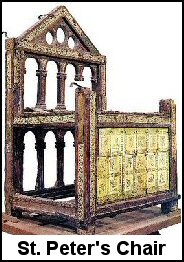
In another volume of The Catholic Encyclopedia. we find these
words: "Gilgamesh, whom mythology transformed into a Babylonian
Hercules...would then be the person designated by the Biblical
Nemrod (Nimrod)." It is curious that Nimrod is likened to
Hercules and carvings associated with Hercules appear on the
so-called "Chair of Peter"!
None of these things would
cause us to think of this chair as being of Christian origin.
A scientific commission appointed by Pope
Paul in July, 1968, reported that no part of the chair is old
enough to date from the days of Peter. Carbon dating and other
tests indicated that the chair is no older than the ninth
century. Clearly, the earlier ideas about Peter's chair were
interesting, but not accurate.
Near the high altar of St. Peter's is a large
bronze statue of "Peter." Some old writers have argued that
this was originally a statue of Jupiter!-renamed as Peter. Such
was the opinion of the Emperor Leo who published an edict in 628
against the use of statues in worship. Nevertheless, this statue
is looked upon with the most profound veneration and its foot has
been
kissed so many times that
the toes are nearly worn away!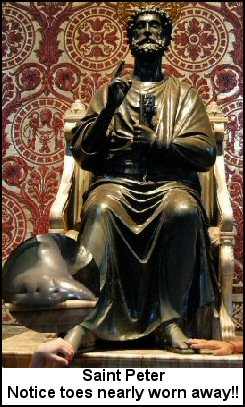
(notice photo on the left)
The
practice
of kissing an idol or statue was borrowed from
sun worship. As we have seen,
Baal worship was linked with the ancient worship of Nimrod in
deified form (
as the sun-god).
In the days of Elijah, multitudes had bowed to Baal and kissed
him. "Yet," God said, "I have left me seven thousand in Israel,
all the knees which have not bowed unto Baal, and every mouth
which hath not kissed him" (1 Kings 19:18). In one of his
"mystery" forms. Nimrod (incarnated in the young Tammuz) was
represented as a calf. Statues of calves were made,
worshiped, and kissed! "They sin more and more, and have
made them molten images of their silver, and idols according to
their own understanding, all of it the work of the craftsmen: they
say to them, Let the men that sacrifice kiss the calves" (Hosea
13: 1-3). Kissing an idol was a part of Baal worship!
Not only was the practice of kissing an idol
adopted by the Roman Catholic church, so was the custom of
religious processions in which idols were carried. Such
processions are a common part of Roman Catholic practice, yet
these did not originate with Christianity. In the fifteenth
century B.C., an image of the Babylonian goddess Ishtar was
carried with great pomp and ceremony from Babylon to Egypt. Idol
processions were practiced tn Greece, Egypt, Ethiopia, Mexico, and
many other countries in olden times.
The Bible
shows the folly of those who think good can come from
idols-idols so powerless they must be carried!
Isaiah, in direct reference to the gods of Babylon, had this to
say: "They lavish gold out of the bag, and weigh silver in the
balance, and hire a goldsmith; and he maketh it a god: they fall
down yea, they worship. They bear him upon the shoulder,
they carry him" (Isaiah 46:6,7).
Not only have
such processions continued in the Roman Catholic church in which
statues are carried, but the pope is also carried in procession.
In Isaiah's time the people lavished silver and gold on their
god. Today expensive garments and jewels are placed on the
pope. When the sun worship
god was carried tn procession, the people fell down and
worshiped, so on certain occasions do people bow before the pope
as he is carried by. Even as the god was carried 'upon the
shoulder,' so do men carry the pope, the god of Catholicism, upon their shoulders in
religious procession!
Over three thousand years ago,
the very
same practice was known in Egypt, such processions being
a part of
sun worship
there. The
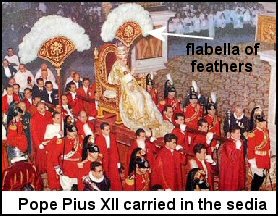
illustration
bottom right corner shows the ancient priest-king of Egypt being
carried through worshipful crowds by twelve men. A
comparison of the papal procession and the ancient
sun worship procession, shows
that one is a copy of the other. In the drawing of the Egyptian
priest-king, we notice the use of the
flabella a large fan made of feathers, later known
as the mystic fan of Bacchus. These fans are also carried
with the pope on state occasions.
.
The Encyclopedia Britannica says, "When going
to solemn ceremonies, (the pope) is carried on the sedia, a
portable chair of red velvet with a high back, and escorted by two
flabella of feathers." That these processional fans
originated in the
sun worship
of Egypt is known and admitted by Catholic writers.
The four strong iron rings in the legs of the
"Chair of Peter", were intended for carrying-poles. But we
can be certain that the apostle Peter was never carried through
crowds of people bowing to him! (Acts 10:25,26).
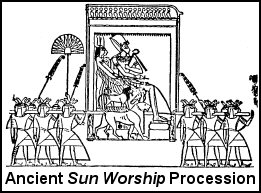
That the papal office was produced by a mixture
of
sun worship and
Christianity there can be little doubt. The
pallium,
the fish-head mitre, the Babylonish garments, the mystic keys,
the title Pontifex Maximus,
were borrowed from sun worship.
All of these things, and the fact that Christ never instituted the
office of Pope in his church, plainly show that the
Pope is neither the Vicar of Christ nor the
successor of the apostle
Peter.
“Signs and symbols rule the Sun Worship world, not words nor
laws.”
www.granddesignexposed.com

 When
Rome conquered the world, the
When
Rome conquered the world, the 


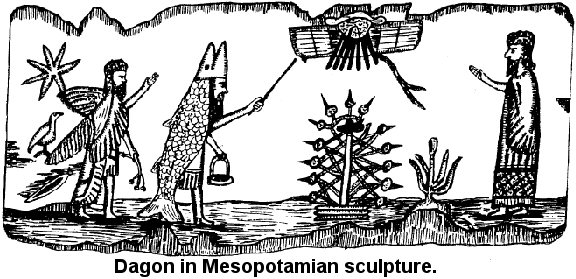



 practiced
among the Greeks!
practiced
among the Greeks! In another volume of The Catholic Encyclopedia. we find these
words: "Gilgamesh, whom mythology transformed into a Babylonian
Hercules...would then be the person designated by the Biblical
Nemrod (Nimrod)." It is curious that Nimrod is likened to
Hercules and carvings associated with Hercules appear on the
so-called "Chair of Peter"!
In another volume of The Catholic Encyclopedia. we find these
words: "Gilgamesh, whom mythology transformed into a Babylonian
Hercules...would then be the person designated by the Biblical
Nemrod (Nimrod)." It is curious that Nimrod is likened to
Hercules and carvings associated with Hercules appear on the
so-called "Chair of Peter"!  (notice photo on the left)
(notice photo on the left) illustration
bottom right corner shows the ancient priest-king of Egypt being
carried through worshipful crowds by twelve men. A
comparison of the papal procession and the ancient
illustration
bottom right corner shows the ancient priest-king of Egypt being
carried through worshipful crowds by twelve men. A
comparison of the papal procession and the ancient 